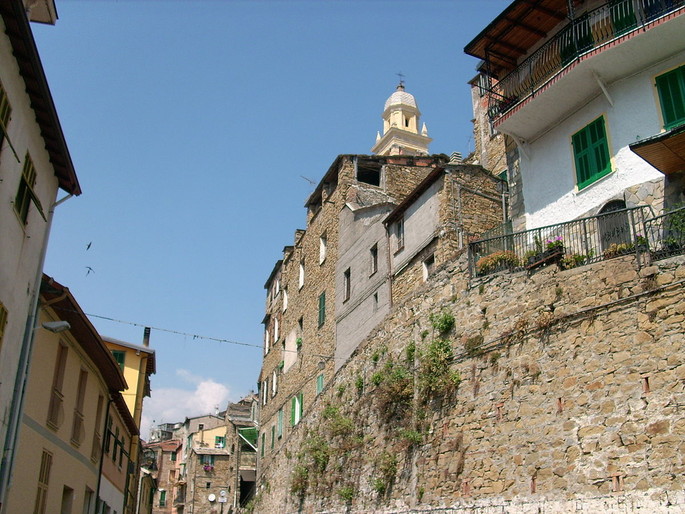You exit from the town of Badalucco, go past a blind curve and tac ... you find yourself in front of this village lying on a hill, in an imposing perspective.
You can read about the romantic legend of this town here.
Certainly Montalto Ligure was founded before 1000, probably by families of the coast who escaped from the invasions of the Saracens and the Lombards. The count Oberto of Ventimiglia really existed: his family dominated this territory for centuries before it came under the control of the Republic of Genoa.
In recent years the town has rediscovered its romantic vocation, a little for the legend, a little for the beauty of its architecture and its views. In addition to lending itself to quality tourism, Montalto Ligure is indeed a destination for couples from all over the world, who decide to get married right here. The most coveted place for ceremonies is the Loggia degli Sposi, an ancient building in the historic center open to the Argentina valley.
But let's find out what there is to see in this country not to be missed.
The historic center: Over the centuries the village has never lost its medieval imprint, so many glimpses have been kept intact that will make you go back in time. At the top of the town once stood a castle that was demolished in the fifteenth century, now some parts are incorporated into later buildings. Around it the rest of the town developed, taking the "pinecone" shape typical of many Ligurian and Provencal villages. This apparently chaotic growth created an incredible network of alleys, stairways, arcades, which hides surprises for the eyes at every turn. You will not miss the opportunities to take pictures. Many black stone portals finely sculpted by local artisans contribute to embellish the ensemble. Surely the focal point of the historic center is the square in front of the parish church, surrounded by airy arches that often host the celebrations connected to weddings. Here you will find a large iron ring where, it seems, that the criminals were tied up exposed to the public, a widespread punishment for minor crimes.
The church of San Giovanni Battista: Built in the fifteenth century, the parish reached its present appearance only at the end of the eighteenth century, when the naves were demolished and six side chapels created. Even the bell tower, of considerable height, dates back to that period. The interior is striking for the richness of the stuccos and the furnishings, with the decorative fantasy typical of the Baroque. It is incredible to think that in these small countries where poverty was at home, could be created such precious buildings. One is equally astonished by the art works present. A "Resurrection" of 1563 bears the signature of Luca Cambiaso, a famous painter who also worked at the court of the King of Spain. The "polyptych of San Giorgio" was instead created by Ludovico Brea, artist whose birthplace Montalto Ligure and Nice are vying. The Brea represents the trait d'union between late medieval and Renaissance painting in the Western Liguria: you can admire many of his masterpieces in Taggia, in the Convent of San Domenico. To complete this extraordinary collection, contribute the paintings by refined local authors such as Agostino da Casanova and Emanuele Macario da Pigna.
Near the parish it is very interesting to visit the Oratory of San Vincenzo Ferrer, probably built following the preaching of the Dominican friar in the Argentina valley. Inside you can admire a splendid altar in painted wood, by Giovanni Battista Borgogno called "Il Buscaglia". A truly remarkable work for the richness of the details, highlighted by the combination of gold on a dark background. It dates back to the end of the seventeenth century. The church of San Giovanni Battista became the parish of the village only in 1618, before it depended on the parish church of San Giorgio.
The parish church of San Giorgio: It is the oldest church in Montalto Ligure, it is thought that the original nucleus dates back to before the thirteenth century. Built near the cemetery, just below the inhabited area, it acquired the Romanesque-Gothic features that it still maintains following changes made in the 14th century. It is divided into three naves by four mighty circular stone columns, of Romanesque style, and two pillars. A stone wall with a built-in lectern divides the area reserved for celebrants from that for the faithful. It houses splendid frescoes by unknown authors, made between the fourteenth and sixteenth centuries. The Gothic cuspid bell tower is very impressive.
The parish churches, usually located in rural areas, were in the Middle Ages the correspondent of the current parishes as the center of Christian community life. But they also had civil administration duties, such as keeping records of births and deaths. It seems that this church was built on a place sacred to the ancient Ligurians. The nearby confluence of the Argentina and Carpasina streams and the numerous springs in the area make it probable that there are cults linked to water, which perhaps were never completely abandoned.
The Sanctuary of Our Lady of Acquasanta: A testimony of this transition between ancient and new religion could be the Sanctuary of the Madonna dell'Acquasanta, reachable after a walk in the greenery taking the mule track at the beginning of the town. It dates back to the 15th century and was built as a thank for a miracle. The Virgin appeared to an elderly lame man from the village and told him to bathe in a spring in the woods, the old man obeyed by curing instantly from his disability. Unfortunately the church has completely lost its original appearance due to the earthquake that in 1887 devastated the province of Imperia. However, some very significant elements have remained, such as the fifteenth-century well from which it is traditional to draw miraculous water.
Nature and gastronomy: In addition to a cultural heritage of considerable interest, Montalto Ligure stands out for the beauty of its territory. The dominant position offers unforgettable views over the Argentina and Carpasina Valleys, the view widens on hills completely covered by olive trees and vines, which give way to chestnut trees as you move away from the town. There are many ways to walk, while on the way you often come across mills and old stone bridges. If you get hungry, don't worry, in Montalto Ligure you will find an excellent choice of restaurants where you can discover the typical dishes of the hinterland. You should definitely try the typical potato-based savory cake called "fràndura".
























